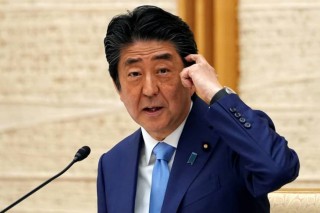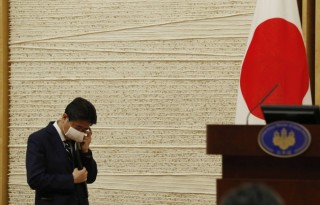Loading
Search
▼ Aging Administrative Pipeline Holds Back Japan's ¥230 Trillion Virus-Response Aid
- Category:Other
Prime Minister Shinzo Abe declared his virus-response package to be the world’s biggest, yet much of it remains stuck in Japan’s aging administrative pipeline, blocked by paperwork, complexity and a lack of staff.
Almost 40 percent of the funds budgeted for cash handouts to households still haven’t reached people despite their approval in late April, according to the Ministry of Internal Affairs and Communications, citing figures to the end of last week.
As for business loans and job-protection subsidies, other key measures in Abe’s ¥233.9 trillion (about $2.2 trillion) package, only 14 percent of the budget earmarked for smaller firms has been lent out, and just 5.8 percent of aid has reached companies maintaining their payrolls.
The upshot is that even with the best of intentions, the government is falling short of the speedy assistance it promised as the economy faces its biggest contraction in more than six decades.
Ayana Amaike, a 32-year-old freelance translator living in Tokyo, was infuriated when three tax bills arrived in her mailbox while she waited more than two weeks just for an acknowledgment that her application form for financial support had been filed.
“It may sound like an ungrateful complaint, but I can’t honestly say I rate the government’s speed of delivery,” said Amaike, whose typical work is converting the fine detail of Japanese electronics and machinery patents into English.
Amaike applied for a program offering up to ¥1 million to freelancers or ¥2 million for small businesses that can show a sharp loss of income.
Kazuko Ito, a nightclub hostess in Tokyo, said she also applied for assistance through the program three weeks ago but, unlike Amaike who has now received the money, Ito said she is still waiting for a response.
The 56-year-old said she couldn’t get through to the government’s helpline and ended up having to get a younger friend’s help to navigate the website.
“You call a hundred times and nobody answers,” she said. “It’s the worst.”
The main cash handout program offers each person ¥100,000 after an earlier plan to target the aid was scrapped over fears it would be delivered too slowly. Instead, the ¥13 trillion measure has itself come under fire for delays and technological slow-footedness.
“The speed is slow,” said economist Harumi Taguchi at IHS Markit, comparing Japan’s performance with other major economies. “I suspect the aid hasn’t really gotten to the people who needed it most, when they needed it most.”
South Korea, which approved similar handouts to all households on the same day as Japan, has essentially finished handing out the cash already. Korea reached the 90 percent distribution mark more than a month ago, as it made better use of a high-tech infrastructure less bound by legacy systems.
Failure to fully harness the benefits of a national identification number has been cited as a factor slowing down applications for the cash. Another factor may simply be a lack of staff to handle claims.
In Setagaya, Tokyo’s largest ward with over 900,000 people, only 15 percent of households that applied for the cash had received their handout as of Friday.
On the small island of Naoshima in Kagawa Prefecture, famed for its art museums and Tadao Ando architecture, 97 percent of 3,000 eligible islanders had received the handout as of Monday.
“Japan has one of the smallest governments internationally. Overall operations are extraordinarily slow because they’re cut to the bone,” said Martin Schulz, chief policy economist at Fujitsu Ltd.
Many local governments including Tokyo’s Chofu city had to stop online applications for the cash handouts as it was taking so much time to confirm details with incomplete applications or households filing multiple requests.
Almost 40 percent of the funds budgeted for cash handouts to households still haven’t reached people despite their approval in late April, according to the Ministry of Internal Affairs and Communications, citing figures to the end of last week.
As for business loans and job-protection subsidies, other key measures in Abe’s ¥233.9 trillion (about $2.2 trillion) package, only 14 percent of the budget earmarked for smaller firms has been lent out, and just 5.8 percent of aid has reached companies maintaining their payrolls.
The upshot is that even with the best of intentions, the government is falling short of the speedy assistance it promised as the economy faces its biggest contraction in more than six decades.
Ayana Amaike, a 32-year-old freelance translator living in Tokyo, was infuriated when three tax bills arrived in her mailbox while she waited more than two weeks just for an acknowledgment that her application form for financial support had been filed.
“It may sound like an ungrateful complaint, but I can’t honestly say I rate the government’s speed of delivery,” said Amaike, whose typical work is converting the fine detail of Japanese electronics and machinery patents into English.
Amaike applied for a program offering up to ¥1 million to freelancers or ¥2 million for small businesses that can show a sharp loss of income.
Kazuko Ito, a nightclub hostess in Tokyo, said she also applied for assistance through the program three weeks ago but, unlike Amaike who has now received the money, Ito said she is still waiting for a response.
The 56-year-old said she couldn’t get through to the government’s helpline and ended up having to get a younger friend’s help to navigate the website.
“You call a hundred times and nobody answers,” she said. “It’s the worst.”
The main cash handout program offers each person ¥100,000 after an earlier plan to target the aid was scrapped over fears it would be delivered too slowly. Instead, the ¥13 trillion measure has itself come under fire for delays and technological slow-footedness.
“The speed is slow,” said economist Harumi Taguchi at IHS Markit, comparing Japan’s performance with other major economies. “I suspect the aid hasn’t really gotten to the people who needed it most, when they needed it most.”
South Korea, which approved similar handouts to all households on the same day as Japan, has essentially finished handing out the cash already. Korea reached the 90 percent distribution mark more than a month ago, as it made better use of a high-tech infrastructure less bound by legacy systems.
Failure to fully harness the benefits of a national identification number has been cited as a factor slowing down applications for the cash. Another factor may simply be a lack of staff to handle claims.
In Setagaya, Tokyo’s largest ward with over 900,000 people, only 15 percent of households that applied for the cash had received their handout as of Friday.
On the small island of Naoshima in Kagawa Prefecture, famed for its art museums and Tadao Ando architecture, 97 percent of 3,000 eligible islanders had received the handout as of Monday.
“Japan has one of the smallest governments internationally. Overall operations are extraordinarily slow because they’re cut to the bone,” said Martin Schulz, chief policy economist at Fujitsu Ltd.
Many local governments including Tokyo’s Chofu city had to stop online applications for the cash handouts as it was taking so much time to confirm details with incomplete applications or households filing multiple requests.
The limitations of the government apparatus revealed by the coronavirus should serve as an enormous incentive to drive digitalization and reform, Schulz added.
Japan announced plans Tuesday to upgrade the country’s digital infrastructure.
“Because the response has been slow, there are people who have gone out of business,” said Nobuyasu Atago, economist at Okasan Securities. “We’ll have to wait and see how many people have gone bust.”
While bankruptcy rates have not shot up yet, the number of people idled has. In April, another 4.2 million people were on leave compared with the month before. Some 143,380 applications for the furlough program have been accepted from companies so far.
Setsuo Yokoyama, a 73-year old owner of a small metal working business near Nagoya that makes parts for barbecue grills, applied for one of the virus-response loans in late May. He received the ¥20 million loan last week, and has three years to pay it back.
Yokoyama said it was safer to have money on hand because it could be months before the return of anything like normal business.
“I was happy to keep plugging away until this happened,” said Yokoyama. “But all of this trouble has made me think it’s time to call it quits.”
Japan announced plans Tuesday to upgrade the country’s digital infrastructure.
“Because the response has been slow, there are people who have gone out of business,” said Nobuyasu Atago, economist at Okasan Securities. “We’ll have to wait and see how many people have gone bust.”
While bankruptcy rates have not shot up yet, the number of people idled has. In April, another 4.2 million people were on leave compared with the month before. Some 143,380 applications for the furlough program have been accepted from companies so far.
Setsuo Yokoyama, a 73-year old owner of a small metal working business near Nagoya that makes parts for barbecue grills, applied for one of the virus-response loans in late May. He received the ¥20 million loan last week, and has three years to pay it back.
Yokoyama said it was safer to have money on hand because it could be months before the return of anything like normal business.
“I was happy to keep plugging away until this happened,” said Yokoyama. “But all of this trouble has made me think it’s time to call it quits.”
- June 24, 2020
- Comment (0)
- Trackback(0)



